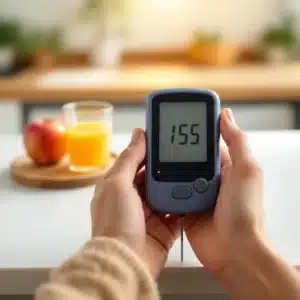When Blood Sugar is High: Symptoms & Immediate Actions

That familiar, creeping fatigue, the unquenchable thirst, or the brain fog that just won’t lift—these are more than just ‘off’ days, aren’t they? For those of us managing diabetes, they’re often the first tell-tale signs that our blood sugar is high. Learning to recognize these symptoms is your first line of defense, a skill that truly empowers you to regain control before things escalate.
That’s exactly what this guide is for. We’re going to walk through the signals your body is sending, break down what they mean, and give you clear, actionable steps to bring your levels back into a safer range. And yes, we’ll also tackle that pressing question: just how high does your blood sugar need to be before you start feeling it?
The “Too High” Number: When Does Blood Sugar Start Causing Symptoms?
If you’re managing diabetes, the question “How high is too high?” is one of the most fundamental—and personal—you’ll ever ask. While there are clear clinical guidelines, the actual number on your meter that makes you feel off can be a bit of a moving target. Let’s break down the official numbers and then get into why your own experience might be different.
In the medical world, the term for high blood sugar is hyperglycemia. Healthcare pros use specific benchmarks to define it, usually by looking at two key moments:
- Fasting Blood Sugar: This is your glucose level after you’ve gone at least eight hours without food or drink (except water), typically checked first thing in the morning. A fasting level of 126 mg/dL (7.0 mmol/L) or higher is officially in the hyperglycemic zone.
- Post-Meal (Postprandial) Blood Sugar: This is your reading two hours after you start eating. The general goal is to stay below 180 mg/dL (10.0 mmol/L).
These numbers are vital for diagnosis and for setting goals with your doctor. But here’s the most important thing to remember: the clinical definition of “high” and the number where you personally start to feel unwell can be two very different things.
Think of it like a car alarm. For someone whose blood sugar is usually well-controlled, a spike to 190 mg/dL might set off all the alarms—intense thirst, fatigue, you name it. But for someone whose body has gotten used to running at higher levels, say around 250 mg/dL or more, that alarm might not go off at all. Their body has adapted, essentially dulling its own warning system.
This is precisely when blood sugar is high and becomes so dangerous—it can cause silent damage without you even feeling a thing. The key takeaway? Trust your meter, not just your symptoms. It’s the only way to know what’s truly happening inside your body.
Listening to Your Body: Early Warning Signs of a Glucose Spike
Your body has its own language, and learning to speak it is one of the most powerful skills you can have when managing diabetes. Long before your meter flashes a high number, your body often sends out subtle (and sometimes not-so-subtle) warnings. Catching these early signs is a game-changer because it lets you act before a minor spike turns into a major problem. When your blood sugar is high, your system kicks into overdrive to fix the imbalance, and the side effects of that effort are what you feel as symptoms.
Here are the most common early warnings to look out for:
The Classic Trio: Thirst, Urination, and Hunger
These three are often the most obvious signs of hyperglycemia. They’re all directly connected to your body’s frantic attempt to deal with all that extra glucose.
- Excessive Thirst (Polydipsia): Do you suddenly feel parched, like no amount of water can touch your thirst? When your blood sugar is high, your kidneys work overtime to filter the extra sugar out of your blood. This process pulls a ton of fluid from your tissues, leaving you dehydrated and triggering that intense, desperate need to drink.
- Frequent Urination (Polyuria): That constant need to run to the bathroom isn’t just your imagination. As your kidneys dump that excess sugar, they do it through urine. This means you’ll be going more often and in larger amounts than usual. It’s a crystal-clear signal that your body is trying to get rid of something it can’t handle.
- Unexplained Hunger (Polyphagia): It’s a frustrating paradox, isn’t it? Your blood is full of sugar, yet your cells are starving. Insulin is the key that unlocks your cells to let glucose in for energy. If you don’t have enough insulin, or it isn’t working right, that glucose stays locked out. Your body mistakes this cellular starvation for a need for more food, leading to a nagging hunger, even right after you’ve eaten.
The Sneaky Saboteurs: Fatigue and Brain Fog
Sometimes, the first sign of a spike isn’t a dramatic symptom. It’s a much quieter creep of exhaustion and mental fuzziness.
- Pervasive Fatigue: This isn’t just your typical “I need a coffee” tired. It’s a deep, bone-weary exhaustion that sleep just can’t seem to fix. Because your cells aren’t getting the glucose fuel they need, your whole body is essentially running on empty. This profound lack of energy is a direct result of that fuel delivery breakdown.
- Difficulty Concentrating or “Brain Fog”: High blood sugar can throw a wrench in your brain’s processing power. You might find it hard to focus, struggle to recall simple things, or just feel like your thoughts are moving through mud. Your brain needs a stable supply of glucose to work its best, and sharp spikes can really disrupt clear thinking.
Other Physical Clues to Watch For
- Blurred Vision: High glucose can cause the lens of your eye to swell, temporarily changing its shape and making it hard to focus. This can make your vision blurry. The good news? It’s usually a temporary issue that clears up as your blood sugar comes back down.
- Headaches: The combination of dehydration and the effect of high glucose on the blood vessels in your brain can often trigger dull, persistent headaches.
Think of these symptoms as your body’s check-engine light. When you notice them, don’t just brush them off. Use them as a cue to check your blood sugar, think about your recent meals or activity, and take the steps you need to guide your levels back to safety.
What’s Causing Your High Blood Sugar? Common Triggers to Watch
Seeing an unexpectedly high number on your glucose meter can be so frustrating. You might feel like you’re doing everything by the book, yet your levels are still climbing. Frustrating, right? The truth is, managing diabetes is a bit like being a detective. Figuring out the usual suspects is the first step toward getting things under control. So, when blood sugar is high, it’s time to put on your detective hat and investigate what might be triggering the spike.
Let’s look at some of the most common culprits.
1. Your Plate and Your Glass
What you eat and drink has the most immediate and direct impact on your blood glucose. This might sound obvious, but the details can be tricky.
- Carbohydrates: Foods packed with carbs—like bread, pasta, rice, and potatoes—break down into glucose faster than anything else. Eating a bigger portion than your body or medication is ready for is one of the top reasons for a post-meal spike.
- Hidden Sugars: You’ve got to become a label detective! Processed foods, sauces, salad dressings, and even snacks that seem “healthy” can be loaded with hidden sugars that sabotage your efforts.
- Sugary Drinks: This one’s a biggie. Sodas, fruit juices, and sweetened coffee or tea are like a mainline of sugar straight to your bloodstream, almost guaranteeing a sharp, fast spike.
2. Medication Miscues
Your diabetes medication, whether it’s pills or insulin, is an incredible tool. But its effectiveness hinges on getting the timing and dosage right. A high reading could mean:
- Forgetting a Dose: It happens to the best of us. Missing a scheduled medication leaves your body without the support it needs to handle the glucose from your meals.
- Incorrect Timing: Taking your meds too long before or after you eat can create a mismatch. The medication is peaking when the glucose isn’t there, or the glucose arrives before the medication has kicked in.
- Needing an Adjustment: Our bodies change over time. If your numbers are consistently high, it might be a signal that your current dose isn’t cutting it anymore and needs to be re-evaluated by your doctor.
3. A Lack of Physical Activity
Movement is powerful medicine for blood sugar. When you’re active, your muscles gobble up glucose for energy, which naturally helps bring your levels down. If you have a more sedentary day than usual, your body isn’t using that fuel as efficiently, letting it build up in your blood. You don’t have to run a marathon—even a brisk 15-20 minute walk after a meal can make a world of difference.
4. The Sneaky Saboteur: Stress
Never, ever underestimate the power of your mind over your body. When you’re stressed out—from work deadlines, family drama, or just emotional overload—your body releases stress hormones like cortisol. These hormones are designed for a “fight or flight” response, so they tell your liver to dump stored glucose into your blood for a quick energy boost. The problem? If you’re not actually fighting a lion, that extra sugar just sits there, pushing your levels up.
5. Being Under the Weather
Ever notice that when blood sugar is high, you might also be fighting off a cold? When your body is battling an illness, it releases hormones to help in the fight. Just like with stress, these hormones can raise your blood sugar. On top of that, being dehydrated from a fever can concentrate the glucose in your blood, leading to even higher readings. It’s so important to have a “sick day plan” from your doctor to manage your diabetes when you’re not feeling well.
Your Action Plan: Safe Steps to Lower High Blood Sugar Now
Okay, you’ve got a high number on your meter. First thing’s first: don’t panic. Stressing out can actually release hormones that push your blood sugar even higher. Instead, take a deep breath and follow these safe, immediate steps. Knowing exactly what to do when blood sugar is high is a powerful part of your diabetes management toolkit.
Step 1: The Critical Ketone Check
Before you do anything else, you need to check for ketones, especially if you have Type 1 diabetes. Ketones are like toxic exhaust fumes that build up in your blood when your body, starved for glucose it can’t use, starts burning fat for energy instead. This can lead to a medical emergency called Diabetic Ketoacidosis (DKA).
Action: If your blood sugar is over 240 mg/dL (13.3 mmol/L), use a urine strip or a blood ketone meter to check your levels. Follow the specific advice from your doctor, as their recommended threshold might be different. If you have moderate to high levels of ketones, do not exercise and call your doctor or seek medical attention right away.
Step 2: Hydrate with the Right Fluids
Water is your absolute best friend when blood sugar is high. It helps your kidneys do their job of flushing the excess glucose out of your system. Being dehydrated makes everything worse by concentrating the sugar in your blood.
Action: Drink a large glass of water immediately. Keep sipping on water or other sugar-free, caffeine-free drinks (like herbal tea) over the next few hours. Steer clear of sugary drinks, juice, and regular soda—they will only add fuel to the fire.
Step 3: Follow Your Doctor’s Correction Dose Advice
If your healthcare team has given you a correction plan, now is the time to use it. This is your personalized formula or “sliding scale” that tells you exactly how much rapid-acting insulin to take to bring a high number back down to your target range.
Action: Carefully follow your prescribed correction factor. This is not the time to guess. Administer the exact dose your doctor instructed for your current blood sugar reading. If you’re unsure, don’t have a correction plan, or just feel unwell, the safest bet is always to contact your healthcare provider for guidance before taking extra insulin.
A Quick Note on Gentle Movement
If—and only if—you have checked for ketones and they are not present, a little bit of light activity can help. A gentle 15-20 minute walk can encourage your muscles to use up some of that excess glucose. Avoid anything strenuous, as intense exercise can sometimes cause your body to release more sugar, temporarily making things worse.
Remember, this is your immediate response plan. If you’re seeing consistently high readings, it’s a signal that you need to have a conversation with your doctor to review and possibly adjust your overall diabetes management strategy.
When High Blood Sugar Becomes an Emergency: Recognizing Red Flags
You know the drill. You manage the daily ups and downs of your glucose levels. You know what a high reading feels like and what to do about it. But what happens when blood sugar is high and just keeps climbing, spiraling out of control? It’s absolutely critical to understand when a manageable issue is escalating into a life-threatening medical emergency. Recognizing the danger signs is a non-negotiable skill that could save your life.
One of the most serious conditions to know about is Diabetic Ketoacidosis (DKA). While it’s most common in people with Type 1 diabetes, it can happen in Type 2 as well. DKA occurs when your body is so starved for insulin that it can’t use glucose for fuel. In a desperate move, it starts burning fat at a furious pace. This process creates toxic acids called ketones. As ketones build up, your blood literally turns acidic, triggering a chain reaction of severe problems that demand urgent medical care.
You must stop self-treatment and seek immediate medical attention if your high blood sugar is paired with any of these red-flag symptoms:
- Fruity-Smelling Breath: A very distinct smell, almost like nail polish remover, caused by high ketone levels.
- Nausea and Vomiting: A huge warning sign, especially if you can’t keep any food or liquids down.
- Severe Stomach Pain: This isn’t a mild ache; it’s acute, debilitating abdominal pain.
- Deep, Labored Breathing: Your body may try to “blow off” the excess acid by forcing you to breathe very rapidly and deeply (this is known as Kussmaul breathing).
- Extreme Confusion or Drowsiness: Feeling disoriented, sluggish, or finding it hard to stay awake are signs the condition is affecting your brain.
- High Ketone Levels: A moderate or high reading on your urine strips or blood ketone meter.
For people with Type 2 diabetes, there’s a similar but different emergency called Hyperglycemic Hyperosmolar Syndrome (HHS). HHS involves extremely high blood sugar (often over 600 mg/dL) that leads to severe dehydration and confusion, but typically without the high ketone levels of DKA.
The message is crystal clear: when blood sugar is high and you start experiencing vomiting, confusion, or breathing problems, this is no longer a situation to handle at home. Don’t “wait and see” or hope it will pass. These are your body’s loudest, most urgent alarms. Call 911 or get to the nearest emergency room immediately. In a hyperglycemia emergency, every second counts.
Beyond the Moment: Strategies to Prevent Future Blood Sugar Spikes
Knowing how to react when your blood sugar is already high is an essential skill. But the real win? The true power in managing diabetes lies in preventing those spikes from happening in the first place. Shifting your mindset from reactive to proactive can transform your health and give you an incredible sense of control. It all comes down to building a strong foundation of consistent habits and a great partnership with your healthcare team.
Let’s look at the core strategies that will help you move beyond just treating the number and start creating a more stable, healthy future.
The Power of Consistent Monitoring
Your blood glucose meter or Continuous Glucose Monitor (CGM) is so much more than a tool to confirm a high—it’s your personal data scientist. By monitoring consistently, you get priceless information about how your body responds to food, activity, stress, and medication. You stop just reacting and start seeing patterns. You can finally answer questions like, “Did that oatmeal cause my mid-morning spike?” or “How much did that evening walk really help my numbers?” This data is the key to making smart, personalized tweaks. When you share this log with your doctor, you’re both looking at the big picture, allowing you to fine-tune your plan with real precision.
Master Your Plate with Effective Meal Planning
Food is often the biggest wild card in blood sugar management, but with a little strategic planning, you can make it a predictable and positive part of your day. This isn’t about a miserable, restrictive diet; it’s about balance, consistency, and knowing what works for you.
A great place to start is the “plate method”:
- Fill half your plate with non-starchy veggies (like broccoli, salad, or green beans).
- Fill one quarter with a lean protein (like chicken, fish, or beans).
- Fill the last quarter with complex carbohydrates (like brown rice, quinoa, or a small sweet potato).
Pay close attention to portion sizes and consider learning carbohydrate counting—it’s a powerful way to match your insulin or medication to what you’re eating. Planning meals and snacks ahead of time takes the guesswork out of your day and makes you far less likely to grab a convenience food that will send your numbers soaring.
Your Healthcare Provider is Your Co-Pilot
You are not on this journey alone. Think of your doctor, endocrinologist, or diabetes educator as your co-pilot. They have the map and the clinical expertise, but you’re the one in the driver’s seat every single day. Regular check-ins are absolutely essential. Use those appointments to go over your blood sugar logs, talk about your challenges, and celebrate your victories. This teamwork is what makes successful management possible. Whether it’s tweaking a medication dose, refining your insulin-to-carb ratio, or finding better ways to handle stress, working closely with your provider ensures your plan grows and changes right along with you. By openly discussing what happens when blood sugar is high, you can build a powerful, proactive strategy that keeps you on a steady path to better health.
Understanding the signals your body sends when blood sugar is high is the first step toward feeling truly in control. By recognizing the symptoms, knowing the immediate actions to take—like hydrating and checking your levels—and when to call for help, you empower yourself to manage your health with confidence. Remember, this knowledge is a powerful tool on your journey. Always work with your healthcare provider to create a personalized diabetes care plan that works for you.
FAQ
What are the first signs my blood sugar is too high?
Usually, the first things you’ll notice are feeling much thirstier or hungrier than usual, needing to urinate more often, feeling really tired, or having blurry vision or a headache.
What should I do immediately if I think my blood sugar is high?
First, check your blood sugar with your meter to confirm. Then, drink a big glass of water and make sure to avoid any sugary foods or drinks until your levels start to come down.
How high does my blood sugar need to be before I feel symptoms?
It’s different for everyone, but many people start to feel the effects once their blood sugar climbs above the 180-200 mg/dL range.
What can I do right now to bring my high blood sugar down?
If your doctor has given you a correction dose plan for your insulin, now is the time to use it. A bit of light physical activity, like a short walk, can also help, as long as your levels aren’t extremely high and you don’t have ketones.
How do I stop my blood sugar from getting high in the first place?
The best defense is a good offense! Sticking to a routine of consistent monitoring, eating balanced meals, getting regular exercise, and taking your medication as prescribed are the cornerstones of preventing spikes.
Scientific References
- Hyperglycemia: A Review of Current Treatments and Emerging Therapies
- Symptoms and Management of Hyperglycemia in Diabetes
- The Impact of Physical Activity on Blood Glucose Control in Type 1 Diabetes: A Systematic Review
- Understanding and Managing High Blood Sugar (Hyperglycemia) in Diabetes
- Hydration and Blood Glucose Levels in Individuals with Type 2 Diabetes


